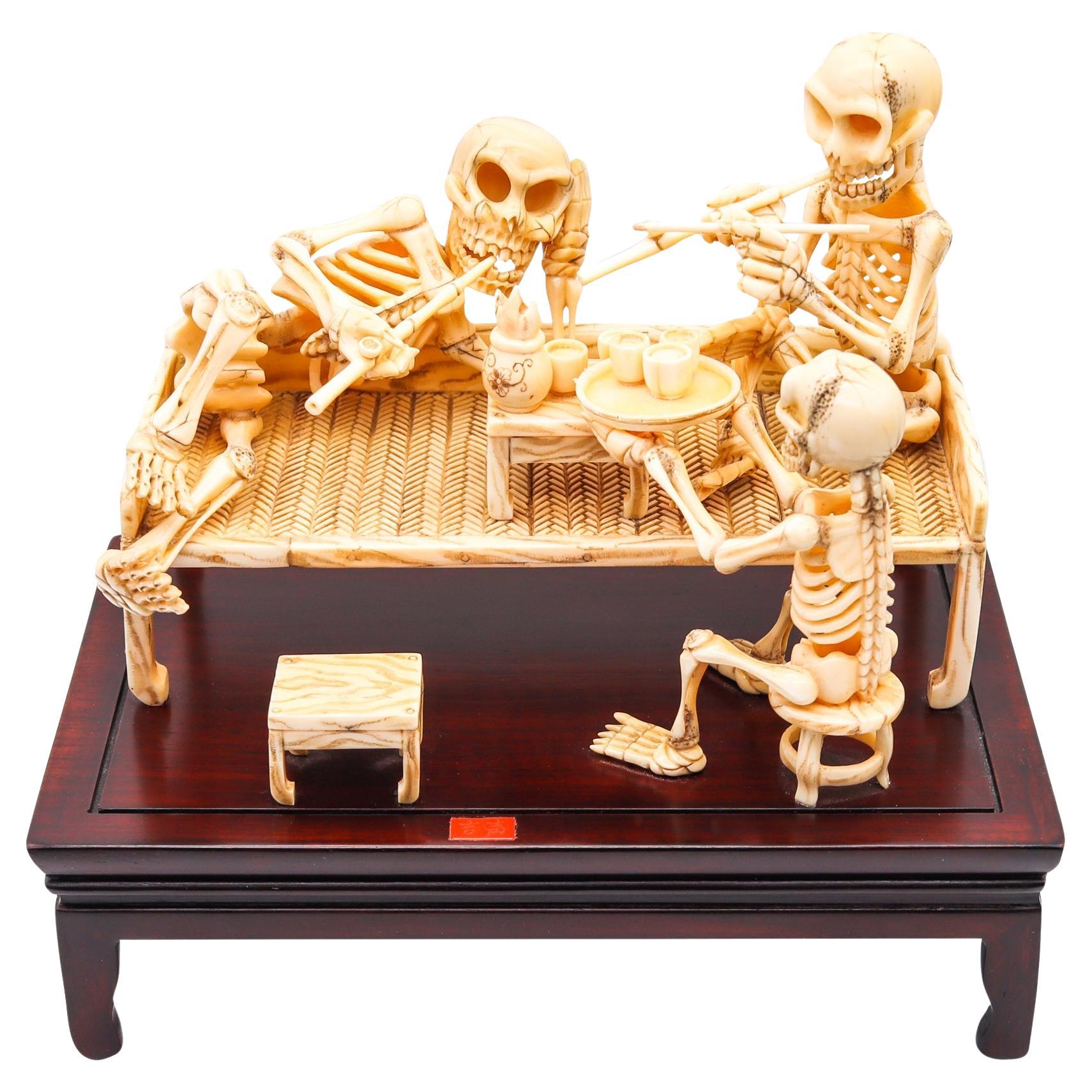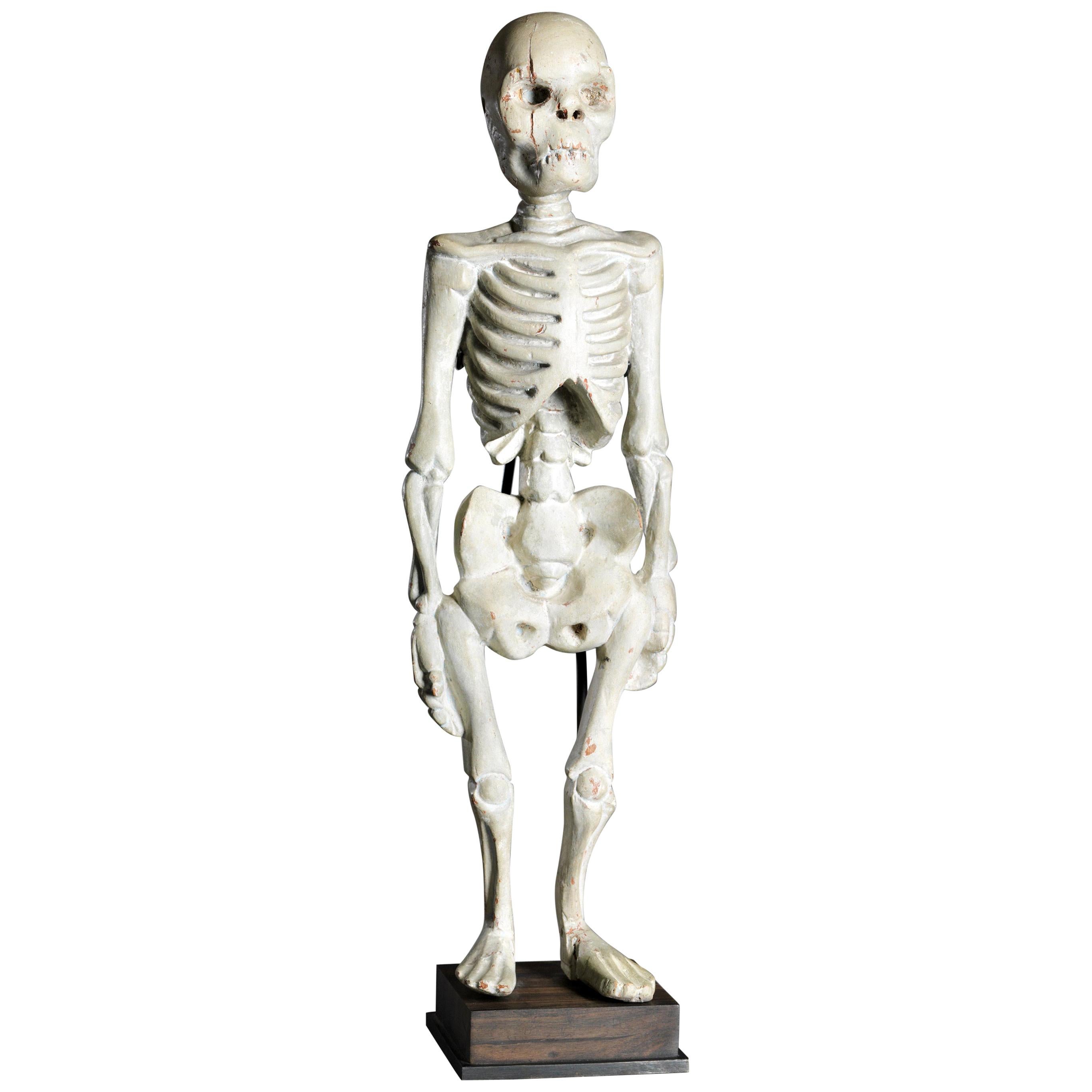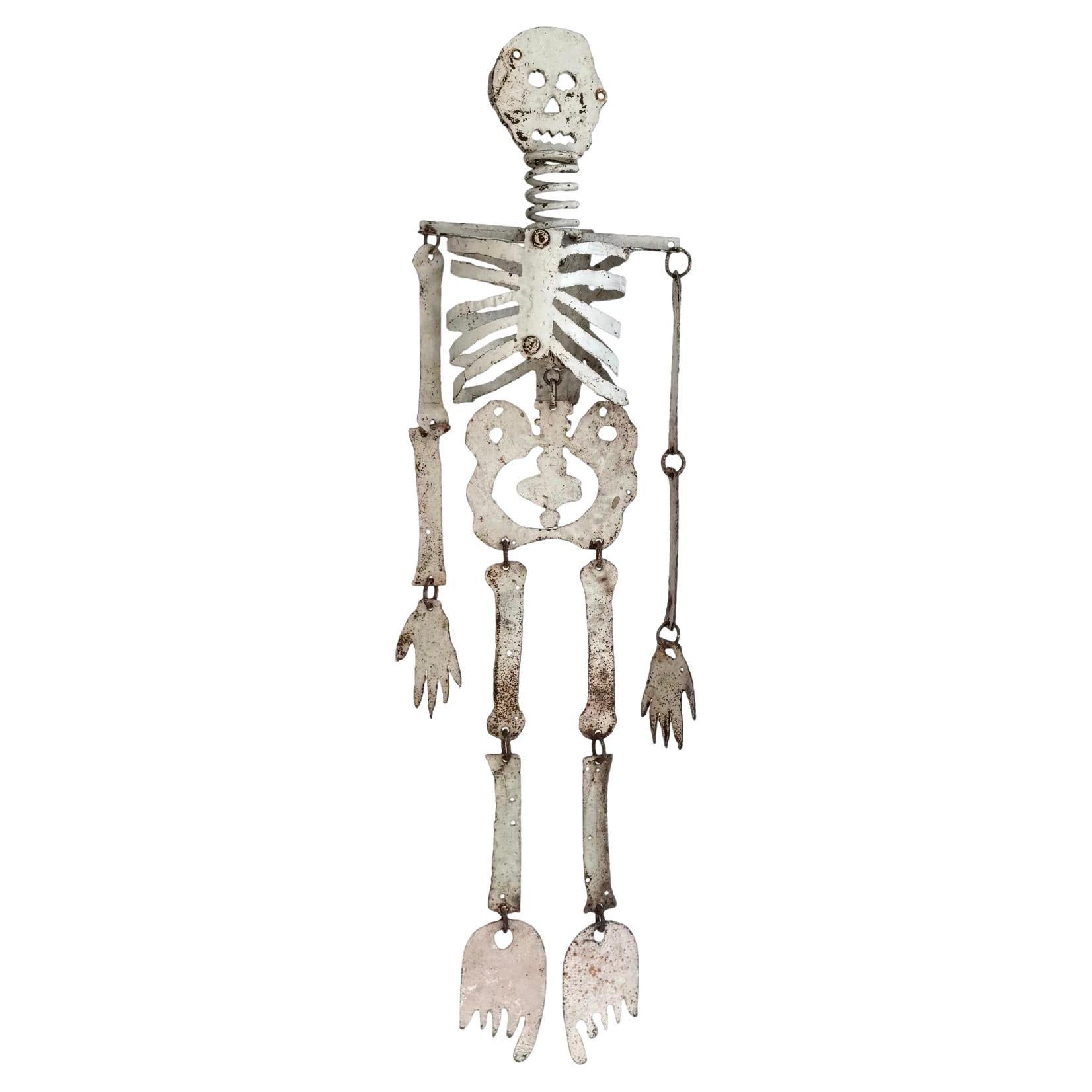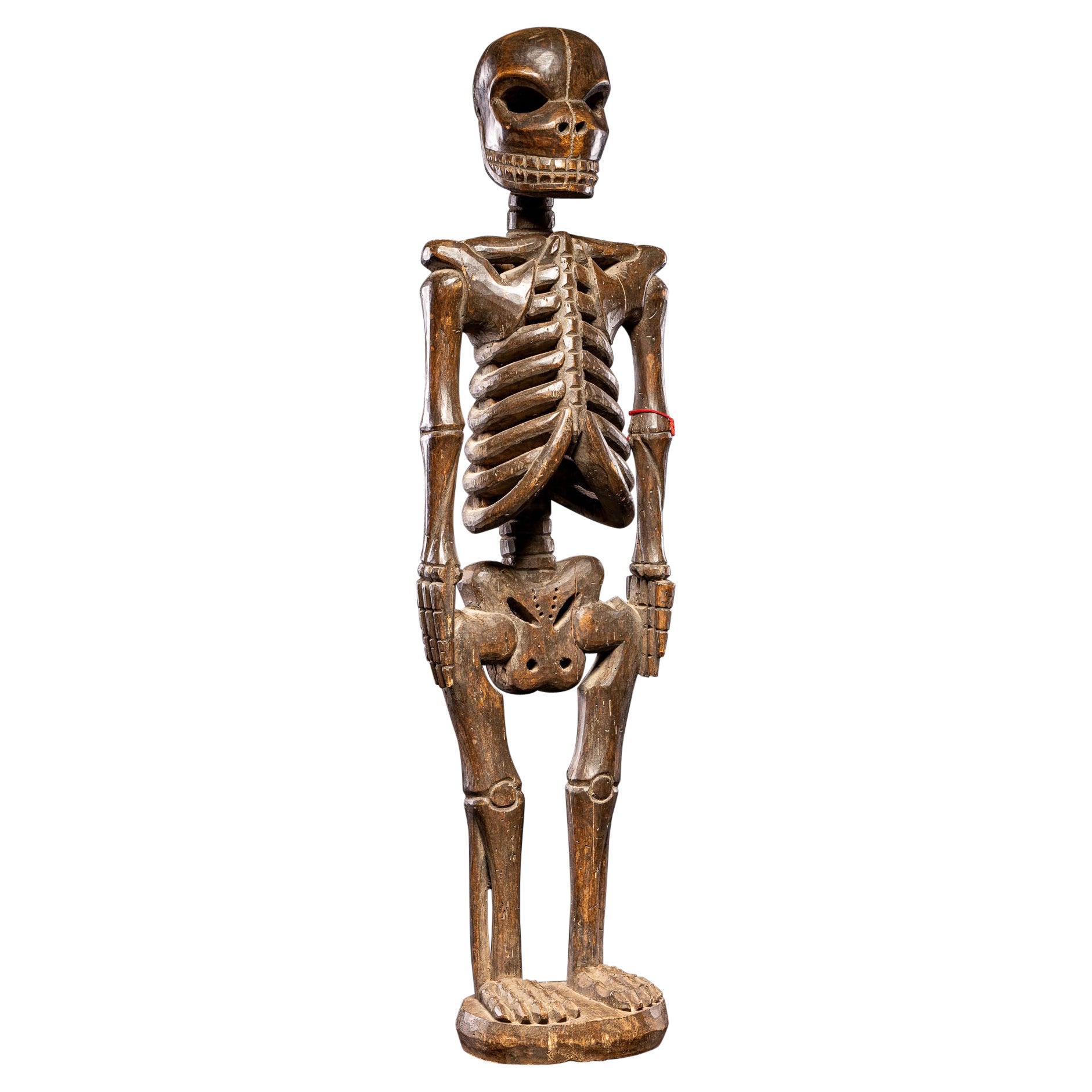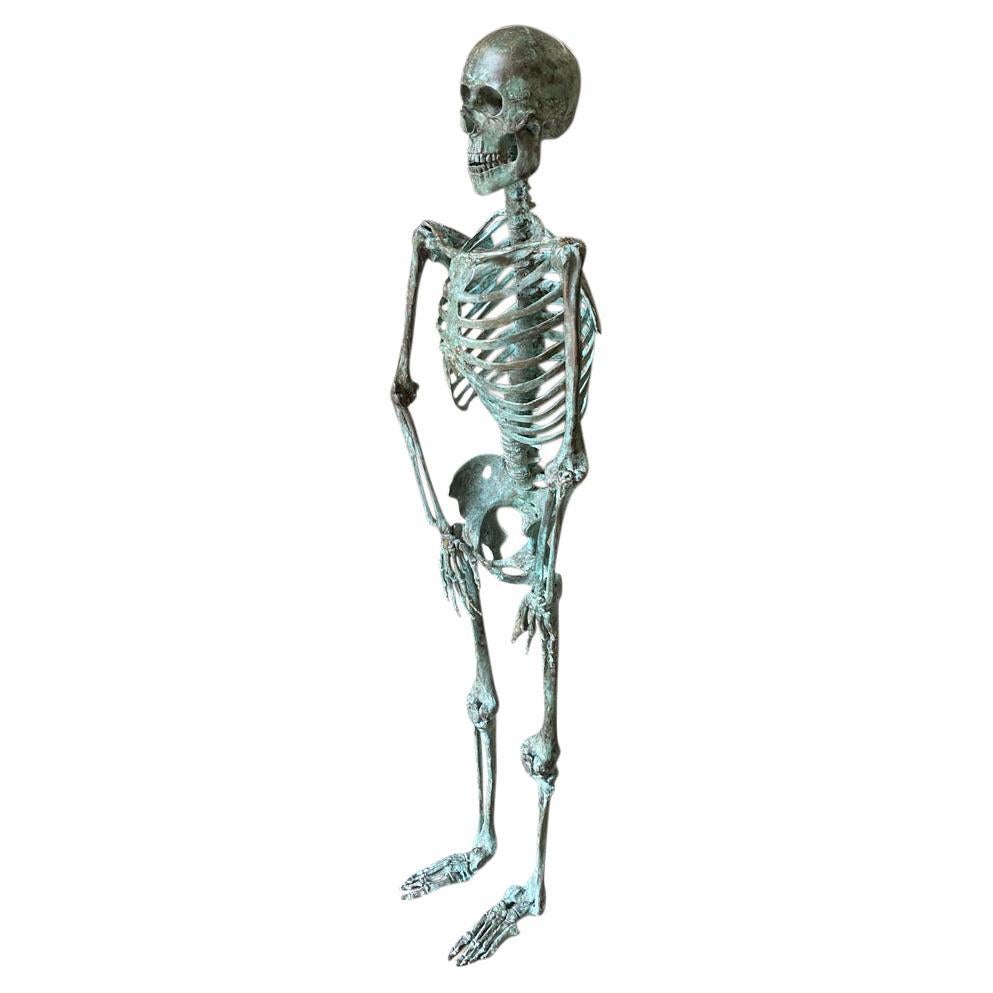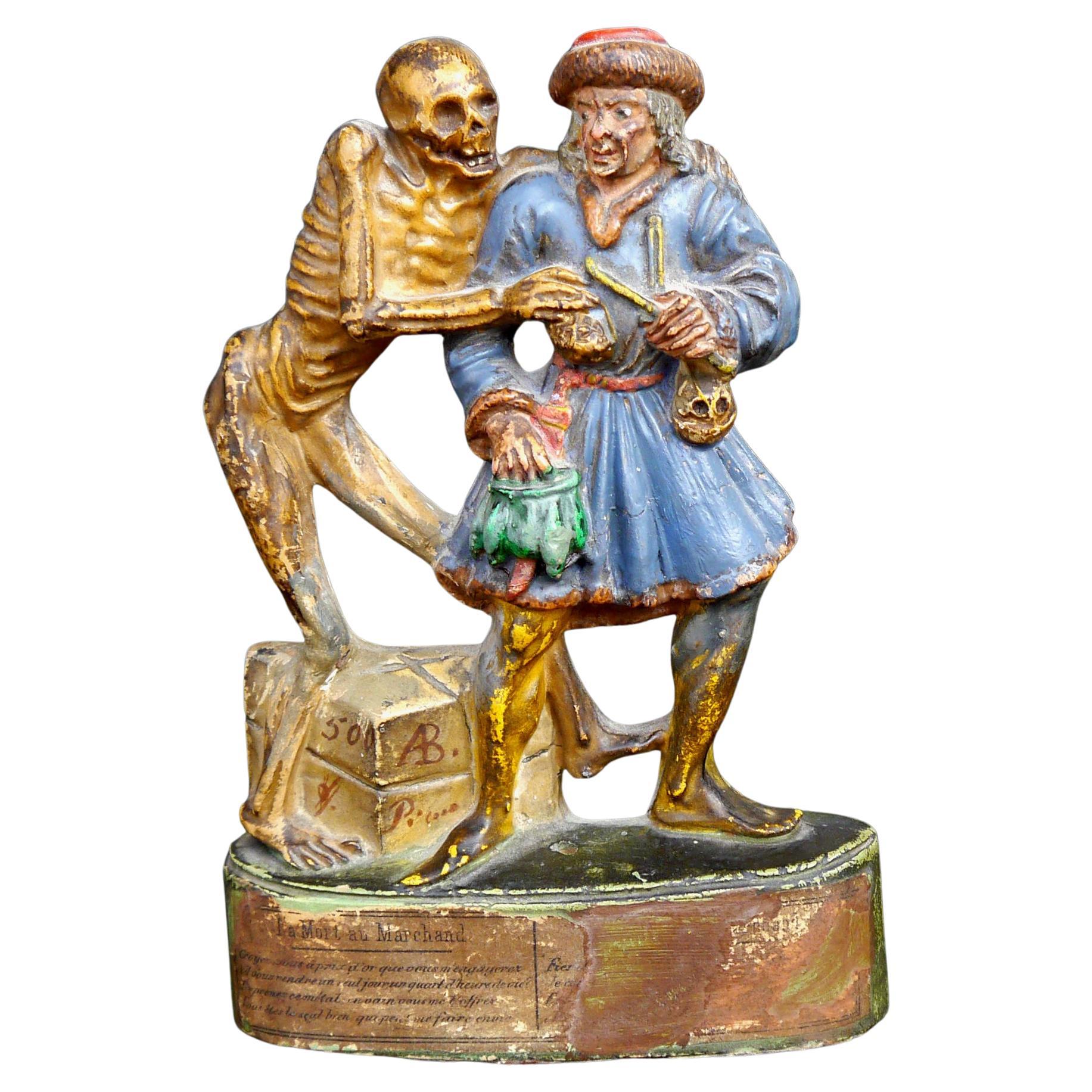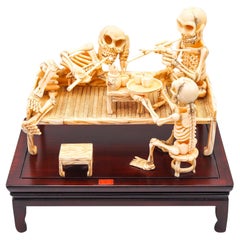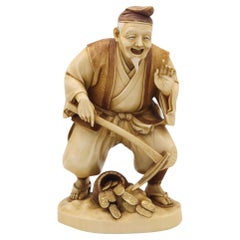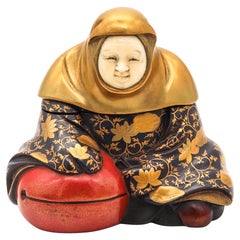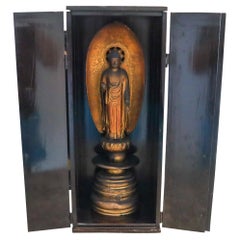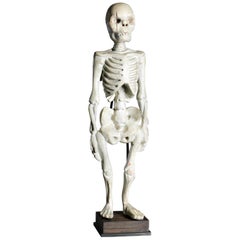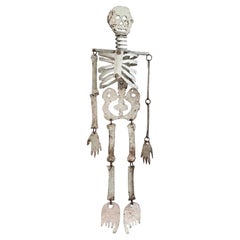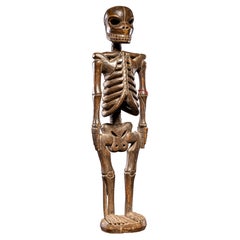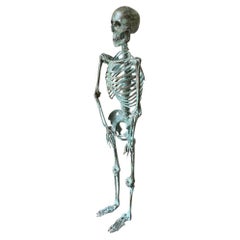Articoli simili a GIAPPONE 1890 Scultura Okimono del periodo Meiji con un gruppo di scheletri che giocano
Vuoi altre immagini o video?
Richiedi altre immagini o video al venditore
1 di 12
GIAPPONE 1890 Scultura Okimono del periodo Meiji con un gruppo di scheletri che giocano
13.008,79 €
17.345,06 €25% in meno
Informazioni sull’articolo
Un Okimono firmato del periodo Meiji giapponese (1868-1912).
Rarissimo, insolito e grande assemblaggio scultoreo di un pezzo di okimono in disimpegno. Creato in Giappone durante il periodo imperiale Meiji (1868-1912). Questo straordinario okimono è stato accuratamente scolpito nel legno e raffigura un gruppo di quattro rappresentazioni di scheletri maschili (Gaikotsu), intricati e realistici, in piedi in diverse posizioni.
Uno scheletro è accovacciato e gioca con i mouse sul pavimento. Il secondo è seduto, appoggiato alla schiena dell'altro, e fuma pacificamente l'oppio. Gli altri due sono completamente in piedi in posizione di interazione. L'intera composizione è disposta liberamente sulla base in legno e comprende un cesto intrecciato, apparentemente con del cibo e quattro topolini giocosi.
Ci sono altri cinque mouse in posizioni diverse, che si muovono liberamente, tutti con gli occhi intagliati in ebano nero.
La composizione è esposta su una piattaforma a quattro gambe in legno intagliato a forma libera con una targa rossa intarsiata con la firma dell'artista. Il livello di dettaglio e la qualità dell'intaglio sono davvero eccezionali.
Le misure esatte sono 216,15 mm per 139,7 mm per 359,41 mm (8,51 x 5,5 x 14,15 pollici).
Dopo un'ampia raccolta di dati, confronti e riferimenti a questo pezzo, siamo riusciti a trovare solo tre sculture okimono come questa, con temi simili e la stessa qualità di lavoro.
Riferimenti Nota: una scultura simile di quattro scheletri che giocano una partita animata a domino, firmata Shutaro in una placca rettangolare rossa intarsiata, è stata venduta a Londra da Christie's South Kensington il 14 ottobre 2014, lotto 120 vendita 5546.
Nota di riferimento: un'incisione simile con quattro scheletri in una scena altrimenti tipicamente vittoriana di un fotografo e tre sitter firmata Shutaro in una placca rettangolare rossa intarsiata, è stata venduta a Edimburgo da Lyon & Turnbull il 7 novembre 2018.
Nota di riferimento: un'incisione simile con cinque scheletri seduti che giocano a carte e bevono è stata venduta a Londra da John Nicholson Fine Art il 26 settembre 2018.
Periodo Meiji
L'era Meiji è stata la prima metà dell'Impero del Giappone, quando il popolo giapponese passò da una società feudale isolata e a rischio di colonizzazione da parte delle potenze occidentali al nuovo paradigma di uno stato nazionale moderno e industrializzato e di una grande potenza emergente, influenzata dalle idee scientifiche, tecnologiche, filosofiche, politiche, legali ed estetiche occidentali. Come risultato dell'adozione di idee radicalmente diverse, i cambiamenti del Giappone furono profondi e influenzarono la sua struttura sociale, la politica interna, l'economia, le forze armate e le relazioni estere. Il periodo corrispondeva al regno dell'imperatore Meiji. Fu preceduta dall'era Keiō e fu succeduta dall'era Taishō, con l'ascesa dell'imperatore Taishō.
Okimono
È un termine giapponese che indica un ornamento, un oggetto d'arte o un oggetto decorativo, solitamente esposto in un tokonoma o in un butsudan "altare buddista". Si tratta di un ornamento o di una figura, soprattutto se collocata in una stanza degli ospiti. Un okimono può essere una piccola scultura giapponese, simile ma più grande di un netsuke. A differenza del netsuke, che aveva uno scopo specifico, l'okimono è esclusivamente decorativo e veniva esposto nel tokonoma. Durante il periodo Meiji, furono realizzati molti okimono da esportare in Occidente.
Gaikotsu, che significa scheletro, compare spesso negli antichi miti giapponesi e nei disegni degli Youkai. Gli scheletri con sole ossa umane sono chiamati "sharekoube". Altri Youkai famosi basati sullo scheletro sono Gasha Dokuro, Honeonna e Kyoukotsu.
Nota importante: per quanto riguarda il guscio di tartaruga o l'avorio antichi, siamo grandi sostenitori della protezione delle specie in via di estinzione nel nostro mondo moderno. Non compriamo o vendiamo mai nulla che abbia più di 100 anni o più recente, non cacciamo, sapendo che queste misure proteggono anche gli animali selvatici di oggi. Riconosciamo anche la vasta storia culturale che preserviamo con la nostra cura e riverenza per questi oggetti antichi e concordiamo con le citazioni che gli oggetti con più di 100 anni non hanno nulla a che fare con l'impoverimento delle specie nel nostro mondo attuale.
Condizioni: Le condizioni generali di questo pezzo sono eccezionali, senza parti mancanti o rotte, e non presentano nemmeno un restauro. Questo pezzo è stato accuratamente ispezionato per garantirne le condizioni e l'autenticità.
RIF. INVENTARIO: D012625EM/.6714
- Dimensioni:Altezza: 13,97 cm (5,5 in)Larghezza: 21,62 cm (8,51 in)Profondità: 35,95 cm (14,15 in)
- Stile:Meiji (Del periodo)
- Materiali e tecniche:
- Luogo di origine:
- Periodo:
- Data di produzione:1890
- Condizioni:Usura compatibile con l’età e l’utilizzo. Le condizioni generali di questo pezzo sono eccezionali, senza parti mancanti o rotte, e non presenta nemmeno un restauro. Questo pezzo è stato accuratamente ispezionato per garantirne le condizioni e l'autenticità.
- Località del venditore:Miami, FL
- Numero di riferimento:Venditore: D012625EM/.67141stDibs: LU8303243370312
Informazioni sul venditore
5,0
Venditore Oro
Venditori Premium con valutazione 4,3+ e tempi di risposta entro 24 ore
Venditore 1stDibs dal 2023
222 vendite su 1stDibs
Tempo di risposta standard: 2 ore
- SpedizioneRecupero del preventivo…Spedizione da: Miami, FL
- Politica di reso
Alcune parti di questa pagina sono state tradotte automaticamente. 1stDibs non può garantire che le traduzioni siano corrette. L’inglese è la lingua predefinita del sito.
Garanzia di autenticità
Nell’improbabile caso in cui si verifichi un problema con l’autenticità di un articolo, contattaci entro un anno per ottenere un rimborso completo. DettagliGaranzia di rimborso
Se il tuo articolo non corrisponde alla descrizione, è danneggiato durante il trasporto o non arriva, contattaci entro 7 giorni per un rimborso completo. DettagliAnnullamento entro 24 ore
Hai un periodo di tolleranza di 24 ore per annullare il tuo acquisto, senza necessità di fornire spiegazioni.Venditori professionali selezionati
I nostri venditori di livello internazionale devono aderire a rigorosi standard di servizio e qualità, garantendo l’integrità delle inserzioni.Garanzia miglior prezzo
Se scopri che un venditore ha pubblicato altrove lo stesso articolo a un prezzo più basso, applicheremo lo stesso prezzo.Consegna globale affidabile
La nostra rete di vettori leader del settore offre opzioni di spedizione specializzate in tutto il mondo, inclusa la consegna personalizzata.Altro da questo venditore
Mostra tuttoGIAPPONE 1890 Periodo Meiji Scultura Okimono di un gruppo di scheletri che fumano
Scultura firmata Okimono del periodo Meiji giapponese (1868-1912).
Rarissimo, insolito e grande assemblaggio scultoreo di un pezzo di okimono in disimpegno. Creato in Giappone duran...
Categoria
Di antiquariato/d’epoca, Anni 1890, Giapponese, Meiji, Sculture e intagli
Materiali
Legno, Lacca
13.008 € Prezzo promozionale
25% in meno
GIAPPONE 1890 Meiji Figura intagliata del dio della fortuna Daikoku come contadino con monete
Una scultura giapponese intagliata di Daikoku.
Magnifica scultura del dio della fortuna Daikoku CON OLTRE 100 ANNI DI ANZIANITA', creata in Giappone durante il periodo Meiji, circa ...
Categoria
Di antiquariato/d’epoca, Anni 1890, Giapponese, Meiji, Sculture e intagli
Materiali
Oro
3244 € Prezzo promozionale
25% in meno
KAZUYOSHI Giappone Meiji 1890 Scatola in legno laccato e dorato con donna seduta e drappeggiata
Una scatola laccata Meiji a forma di donna seduta realizzata da Meigetsusai Kazuyoshi.
Si tratta di un rarissimo cofanetto decorativo realizzato a forma di figura seduta completamen...
Categoria
Di antiquariato/d’epoca, Anni 1890, Giapponese, Meiji, Sculture e intagli
Materiali
Foglia d’oro
3244 € Prezzo promozionale
25% in meno
GIAPPONE 1810 Periodo Edo Grande altare domestico Butsudan con Amida Nyorai in Wood
Grande altare domestico butsudan con figura di Amida Nyorai Periodo Edo (1600-1868)
Si tratta di una bellissima statua giapponese in legno di Amida Nyorai Buddha in piedi, risalente...
Categoria
Di antiquariato/d’epoca, Anni 1810, Giapponese, Edo, Sculture e intagli
Materiali
Oro, Ottone
3244 € Prezzo promozionale
25% in meno
CINA REPUBBLICANA XX secolo Statua di Buddha in porcellana Zeng Long Sheng
Un Buddha seduto della Repubblica Cinese in porcellana.
Si tratta di una bellissima figura devozionale antica di un Buddha felice seduto creata nella Repubblica Cinese all'inizio de...
Categoria
Vintage, Anni 1920, Cinese, Esportazione cinese, Sculture e intagli
Materiali
Smalto
649 € Prezzo promozionale
25% in meno
GIAPPONE Periodo Edo 1825 Scultura di Buddha seduto in legno massiccio intagliato dorato
Una scultura di Buddha seduto in legno intagliato e dorato del periodo Edo.
Si tratta di una figura in legno intagliato superbamente raffinata di un Buddha seduto con una favolosa d...
Categoria
Di antiquariato/d’epoca, Anni 1820, Giapponese, Edo, Sculture e intagli
Materiali
Oro
2278 € Prezzo promozionale
25% in meno
Ti potrebbe interessare anche
Scheletro umano in piedi di Ethno Design scolpito in Wood, Sud Est Asiatico
La scultura risale all'inizio del XX secolo e presenta una meravigliosa patina.
Categoria
Inizio XX secolo, Birmano, Sculture figurative
Materiali
Legno
Scultura scheletro monumentale di arte popolare, anni '50, USA
Un'emozionante scultura realizzata con pezzi di ferro trovati, tagliati e dipinti. Esoterico, stravagante e affascinante: questo pezzo ha una presenza incredibile. Con un'altezza di ...
Categoria
Vintage, Anni 1950, Americano, Sculture figurative
Materiali
Ferro
Scheletro cerimoniale in legno duro ricavato da un unico pezzo di legno, Nigeria.
Una forma non comune, la figura astratta con la bocca piena di denti che si erge dritta su una base integrale.
Categoria
XX secolo, Nigeriano, Sculture figurative
Materiali
Legno massiccio
Scheletro di bronzo del XIX secolo
Un sensazionale scheletro in bronzo del XIX secolo proveniente dall'Università di Medicina di Lovanio - Belgio. Un'ottima aggiunta a qualsiasi studio medico.
Categoria
Di antiquariato/d’epoca, XIX secolo, Belga, Sculture figurative
Materiali
Bronzo
Antica figura in terracotta della morte e del mercante Basler Totentanz Macabre Zizenhausen
Rarissima statuetta in terracotta raffigurante la Morte e il Mercante - secondo il ciclo della Danse Macabre di Zizenhausen o Totentanz aus Zizenhausen o Danza della Morte di Basilea...
Categoria
Di antiquariato/d’epoca, Anni 1850, Tedesco, Neobarocco, Sculture figura...
Materiali
Terracotta
Antico scheletro umano di dimensioni reali
Circa 1950. Offriamo questo Antico scheletro umano a grandezza reale. Realizzato in resina e base in Wood.
Categoria
Vintage, Anni 1950, Messicano, Altro, Antichità
Materiali
Resina, Legno
